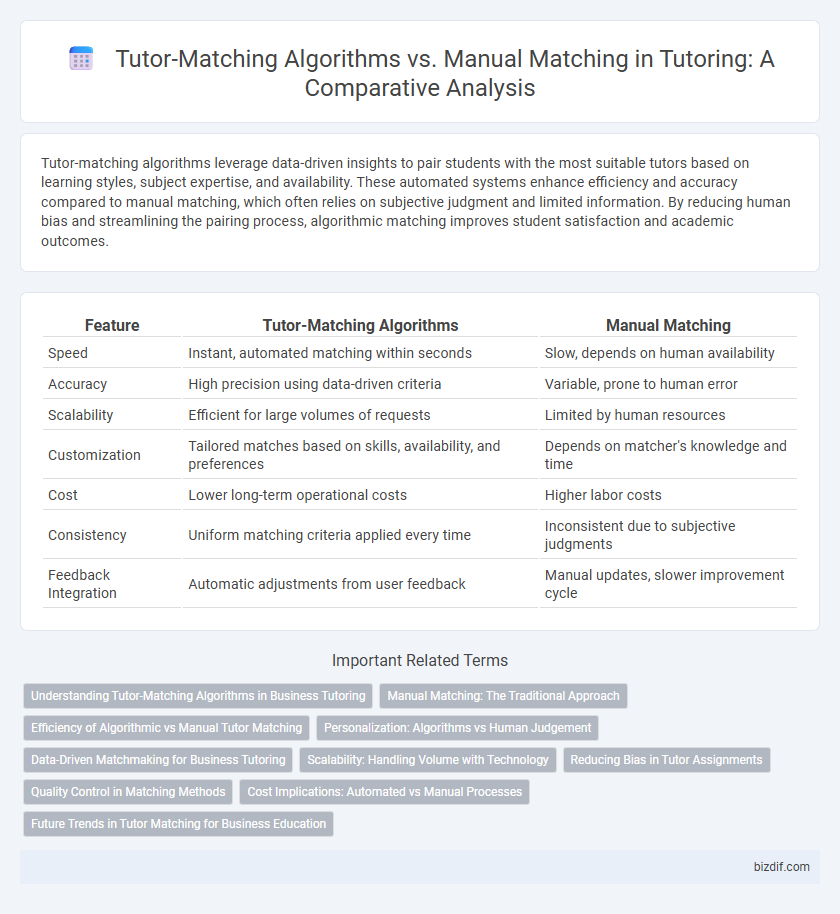Tutor-matching algorithms leverage data-driven insights to pair students with the most suitable tutors based on learning styles, subject expertise, and availability. These automated systems enhance efficiency and accuracy compared to manual matching, which often relies on subjective judgment and limited information. By reducing human bias and streamlining the pairing process, algorithmic matching improves student satisfaction and academic outcomes.
Table of Comparison
| Feature | Tutor-Matching Algorithms | Manual Matching |
|---|---|---|
| Speed | Instant, automated matching within seconds | Slow, depends on human availability |
| Accuracy | High precision using data-driven criteria | Variable, prone to human error |
| Scalability | Efficient for large volumes of requests | Limited by human resources |
| Customization | Tailored matches based on skills, availability, and preferences | Depends on matcher's knowledge and time |
| Cost | Lower long-term operational costs | Higher labor costs |
| Consistency | Uniform matching criteria applied every time | Inconsistent due to subjective judgments |
| Feedback Integration | Automatic adjustments from user feedback | Manual updates, slower improvement cycle |
Understanding Tutor-Matching Algorithms in Business Tutoring
Tutor-matching algorithms leverage data-driven insights to pair students with tutors based on skill compatibility, learning styles, and subject expertise, enhancing the precision and efficiency of matches compared to manual methods. These algorithms analyze vast datasets, including tutor qualifications, student preferences, and performance metrics, to optimize educational outcomes and satisfaction rates. Businesses utilizing algorithmic matching report improved retention and personalized learning experiences, demonstrating significant advantages over traditional manual selection processes.
Manual Matching: The Traditional Approach
Manual matching in tutoring relies on personalized assessment of student needs and tutor expertise, often leading to highly tailored educational experiences. This approach emphasizes human judgment, considering factors such as teaching style compatibility, subject knowledge depth, and individual learning preferences. While manual matching may require more time and effort, it fosters strong tutor-student rapport and adaptability that algorithms might overlook.
Efficiency of Algorithmic vs Manual Tutor Matching
Tutor-matching algorithms streamline the pairing process by rapidly analyzing vast datasets on student needs, tutor expertise, and schedule availability, resulting in higher accuracy and reduced wait times. Manual matching relies on human judgment, which can lead to slower response rates and potential biases, making it less scalable for large tutoring platforms. Efficiency metrics show that algorithmic matching increases successful matches by up to 40% while cutting administrative overhead by over 50%.
Personalization: Algorithms vs Human Judgement
Tutor-matching algorithms leverage data analytics and machine learning to quickly pair students with tutors based on skills, learning styles, and availability, delivering highly personalized recommendations at scale. Human judgement in manual matching excels by considering nuanced emotional intelligence, interpersonal dynamics, and unique student preferences that algorithms may not fully capture. Combining algorithmic precision with human insight results in optimized tutor-student pairings tailored to both academic and personal compatibility.
Data-Driven Matchmaking for Business Tutoring
Data-driven tutor-matching algorithms leverage large datasets and machine learning to efficiently pair business students with tutors whose expertise aligns with specific learning goals and industry needs. These algorithms analyze factors such as subject proficiency, teaching style, and student feedback to optimize match quality and improve academic outcomes. Compared to manual matching, automated systems reduce bias, increase scalability, and continuously learn from engagement metrics to refine recommendations in business tutoring contexts.
Scalability: Handling Volume with Technology
Tutor-matching algorithms efficiently process large volumes of student and tutor profiles by analyzing skills, availability, and learning preferences in real-time, enabling scalable and accurate pairing. Manual matching struggles to keep pace with growing demand due to time-intensive coordination and human error. Leveraging technology reduces administrative overhead and enhances scalability, ultimately improving access to personalized tutoring services.
Reducing Bias in Tutor Assignments
Tutor-matching algorithms utilize data-driven criteria such as student learning styles, subject proficiency, and schedule compatibility to minimize human biases inherent in manual matching. These algorithms enhance fairness by systematically evaluating each tutor's qualifications and matching them objectively to student needs, reducing potential favoritism or subjective judgments. Implementing algorithmic matching supports equitable access to quality tutoring, promoting improved academic outcomes across diverse student populations.
Quality Control in Matching Methods
Tutor-matching algorithms leverage data-driven analysis to evaluate compatibility based on subject expertise, learning styles, and student preferences, ensuring precise pairing that often surpasses manual methods in accuracy. These algorithms reduce human bias and inconsistency, providing scalable quality control in matching by continuously refining recommendations through feedback and performance metrics. Manual matching relies on subjective judgment and experience, which can lead to variability in tutor suitability and affect overall student satisfaction and learning outcomes.
Cost Implications: Automated vs Manual Processes
Automated tutor-matching algorithms significantly reduce costs by minimizing labor-intensive manual efforts and speeding up the pairing process between students and tutors. These algorithms leverage data-driven criteria such as subject expertise, availability, and learning styles to enhance efficiency and optimize resource allocation. In contrast, manual matching incurs higher operational expenses due to the extensive person-hours required and potential for human error leading to mismatches or delays.
Future Trends in Tutor Matching for Business Education
Tutor-matching algorithms leverage machine learning and data analytics to personalize tutor selection based on students' learning styles, performance metrics, and career goals, enhancing the precision and efficiency of the matching process in business education. Manual matching relies heavily on human judgment and qualitative assessment, which can be time-consuming and less scalable compared to algorithm-driven solutions. Future trends indicate a shift towards hybrid models integrating AI-driven algorithms with human insights to optimize tutor matching, improve student outcomes, and adapt to evolving business education demands.
tutor-matching algorithms vs manual matching Infographic

 bizdif.com
bizdif.com